A year to the day after the shooting outside her business, Appollonia Washington finally broke down and really cried.
The 39-year-old owns A 4 Apple Learning Center at the corner of 23rd Avenue and Jackson Street in Seattle’s Central District. On Oct. 16, 2023, a drive-by shooting left a man critically injured and sent bullets flying through the preschool’s front window on a Monday afternoon when more than two dozen kids and staff were inside.
Washington immediately went into triage mode: making sure students and staff were safe; thinking about the business and trying to reassure parents; being there for her mother, who founded A 4 Apple 33 years ago.
That triage spilled into broader community safety work. Washington had already been lobbying the city to address drug use and other issues at the bus stop across the street from A 4 Apple. After the shooting, Washington helped found the Central District Public Safety Accountability group to help community members connect with city leaders on safety issues. She later became co-vice president of the Garfield High Parent Teacher Student Association focused on public safety issues.
On the anniversary of the shooting, while speaking to a reporter, the gravity of what had happened — the violence, the risk to her kids, the risk to herself and her staff — overwhelmed her.
“I never had time to stop and think about my own feelings,” said Washington. “I had to think about these 63 families and reassure them that A 4 Apple is safe. I have to ensure my own safety measures, what I’m going to do for the business. … I remember doing an interview and I just cried. I was like ‘Oh my god, I really haven’t cried since the day’ because I’ve just been active supporting for change.”
As in so many other places across the country, gun violence soared in Seattle and King County during the pandemic. More shots were fired, more people suffered nonfatal injuries, more people died.
In 2019, Seattle had 17 fatal shootings, 64 non-fatal shooting victims and 199 “shots-fired” incidents in which eyewitnesses reported a shooting, there was property damage or investigators found shell casings. Those numbers escalated during the pandemic, hitting a high point in 2023 with 41 fatal shootings, 136 non-fatal shootings and 442 shots-fired reports.
King County saw the same trajectory, with 49 fatal shootings countywide and 206 non-fatal shootings in 2019. By 2023 there were 107 firearm-related homicides and 369 nonfatal shootings across the county. King County data includes Seattle shootings.
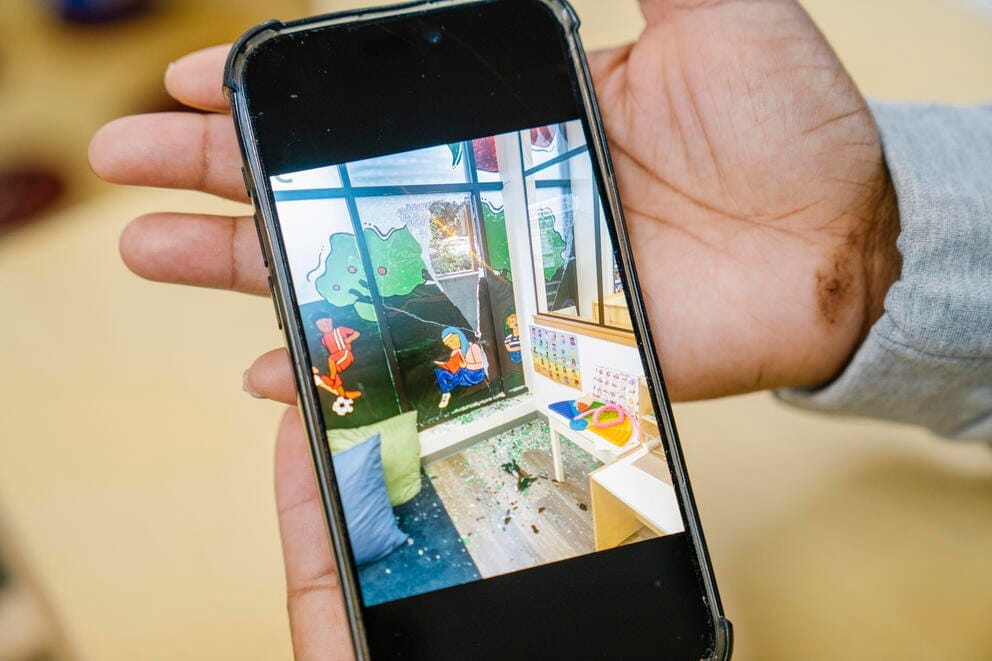
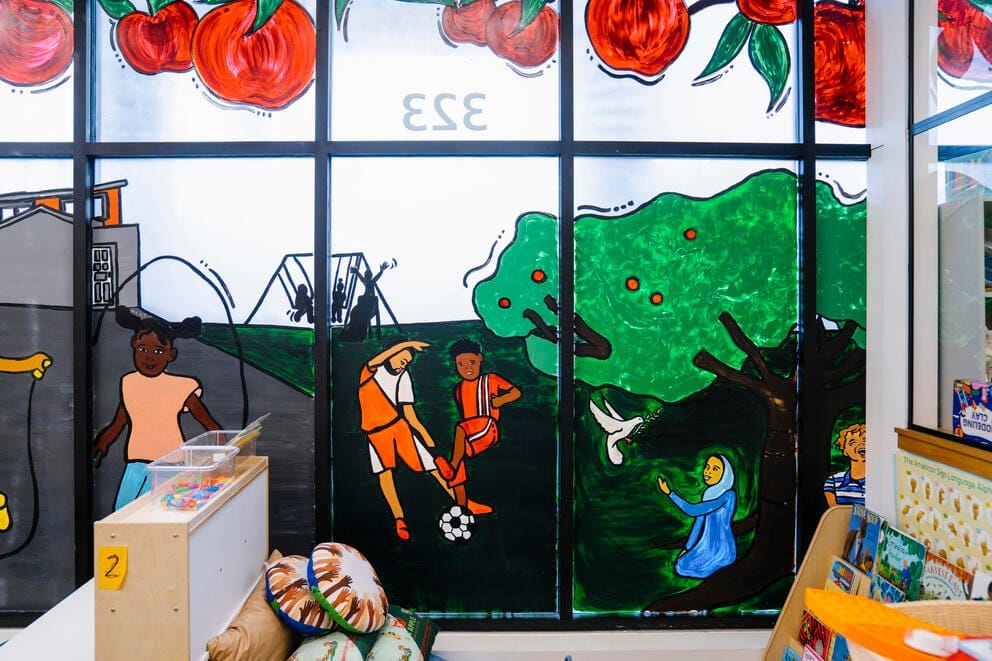
Above: Appollonia Washington displays a photo of a window shattered by gunfire at A 4 Apple Learning Center.
Below: The window in the library corner was repainted by local mural artist Stephanie Morales with a symbol of peace, a flying dove. (M. Scott Brauer/Cascade PBS)
The wave of violence in Seattle and King County appears to have crested, again following national trends. As of Oct. 31, the most recent data from the Seattle Police Department, Seattle has had 28 fatal shootings, 130 nonfatal shootings and 463 shots-fired incidents, putting it on track for a significant decline in shooting victims compared to last year. As of Sept. 30, King County has had 56 fatal shootings, 239 non-fatal shootings and 1,176 shots-fired incidents.
While the decline is of course a positive sign, shootings are a tragedy with lasting impact on victims, families, friends and communities, and the region has a long way to go to eliminate gun violence.
In just the past few weeks, five people were shot and injured at a hookah bar in the Chinatown-International District; a man was murdered outside a bar in Kent; and a 15-year-old was shot and killed in West Seattle’s High Point neighborhood, the second student this year from Chief Sealth International High School to die after being shot.
To understand why Seattle and King County saw such a dramatic rise in gun violence in the wake of the pandemic — especially among men 13-23 — and learn what the city and county are trying to do to address it, Cascade PBS spoke to community organizers, elected officials, government specialists, academics, practitioners and more.
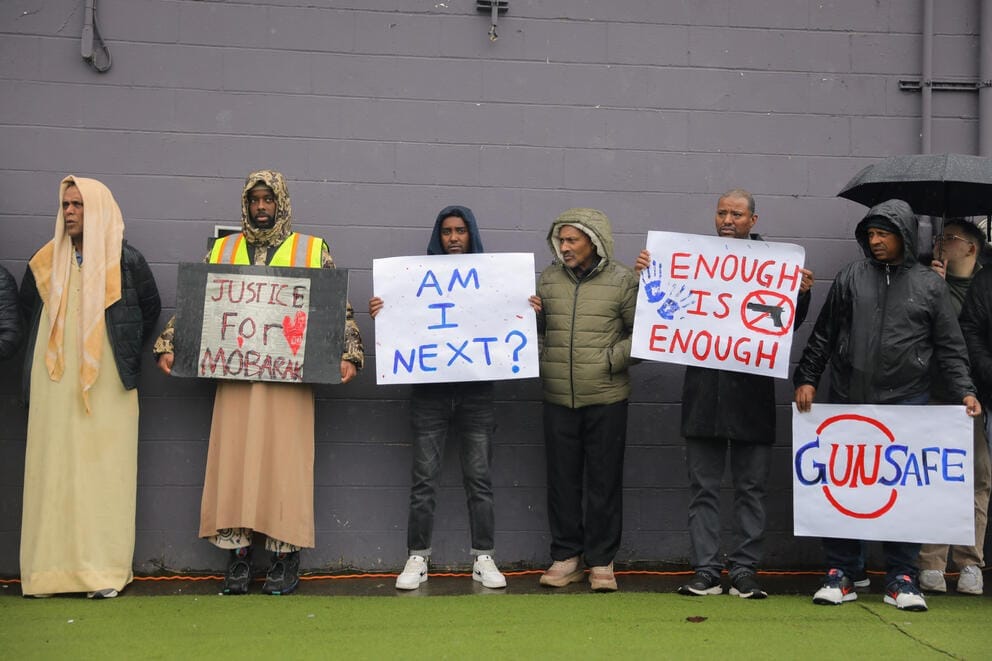
Community members gather for a rally against gun violence several weeks after Mubarak Adam, 15, was fatally shot outside the Southwest Teen Life Center in West Seattle in January 2024. (Genna Martin/Cascade PBS)
Why gun violence rose
There is of course no one reason someone decides to shoot another human, nor a single factor behind the spike in violence of the past five years. But experts say the COVID-19 pandemic’s exacerbation of emotional distress, social dislocation and fear created the perfect conditions for shootings.
“The pandemic itself has led people to feel more isolation, more anxiety, more stress, more anger. People’s lives were destabilized,” said King County Councilmember Girmay Zahilay, who worked this year to increase the county’s investments in gun violence prevention programs.
He continued, “All of a sudden, there’s not a school to go to. There are no afterschool programs to go to. People are staying at home for long periods. There just are not as many outlets as there used to be for people’s anger, frustration, anxiety.”
Though the pandemic worsened the region’s gun violence, the conditions that perpetuate it existed long before the world shut down.
The ubiquity of guns in the United States has always been a factor. “If we had a way to get more guns out of the streets, then gun violence would be a lot less likely to occur,” said Dr. Jacqueline Helfgott, director of Seattle University’s Crime and Justice Research Center, pointing to European countries’ far stricter gun laws and markedly lower gun death rates.
Then Americans rushed to buy more guns during the pandemic, about one-fifth of them first-time gun buyers.
“An increase in global fear led to an increase in people arming themselves for protection or for other reasons,” said Eleuthera Lisch, director of King County’s Office of Regional Gun Violence Prevention.
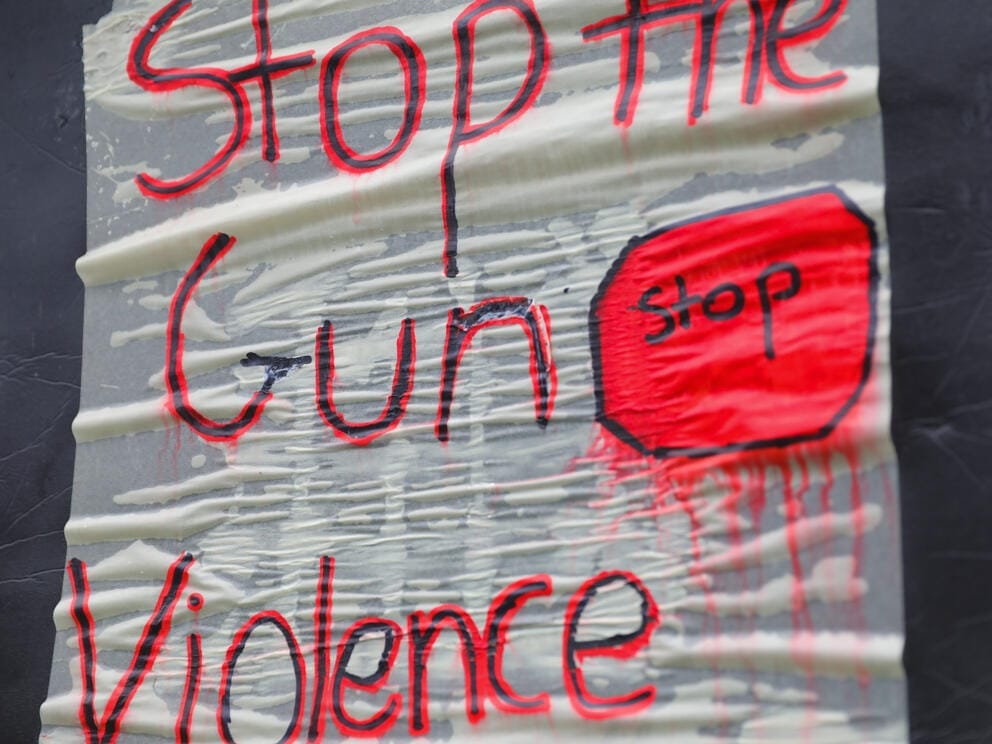
The paint on a sign bleeds in the rain during a rally against gun violence in South Seattle, March 1, 2024. (Genna Martin/Cascade PBS)
Even as total gun violence incidents have gone down, youth gun violence has remained an enormous issue, with some data showing gun violence has become the leading cause of death for children ages 1-17 nationally.
“Our babies are shooting each other,” said Seattle City Councilmember Joy Hollingsworth, who grew up in the Central District and now represents it as part of District 3. “They’re not able to navigate their emotions. I grew up in a much more forgiving society where if you got into a fight, it was just a fistfight. Now people are going home and pulling out guns on each other.”
Hollingsworth sees a few factors at play.
One is a lack of youth activities. “Kids are not bad, they’re bored,” she said. When the Councilmember was growing up, she always had after-school activities like dance, music, basketball practice, snacks and homework help at the Garfield Community Center.
Now she said she sees kids just hanging out at Starbucks on their phones. “Readily available activities for kids just aren’t there. … To find an after-school activity you’ve got to go searching.”
In a similar vein, Washington from A 4 Apple blames a lack of internships and job opportunities for young people.
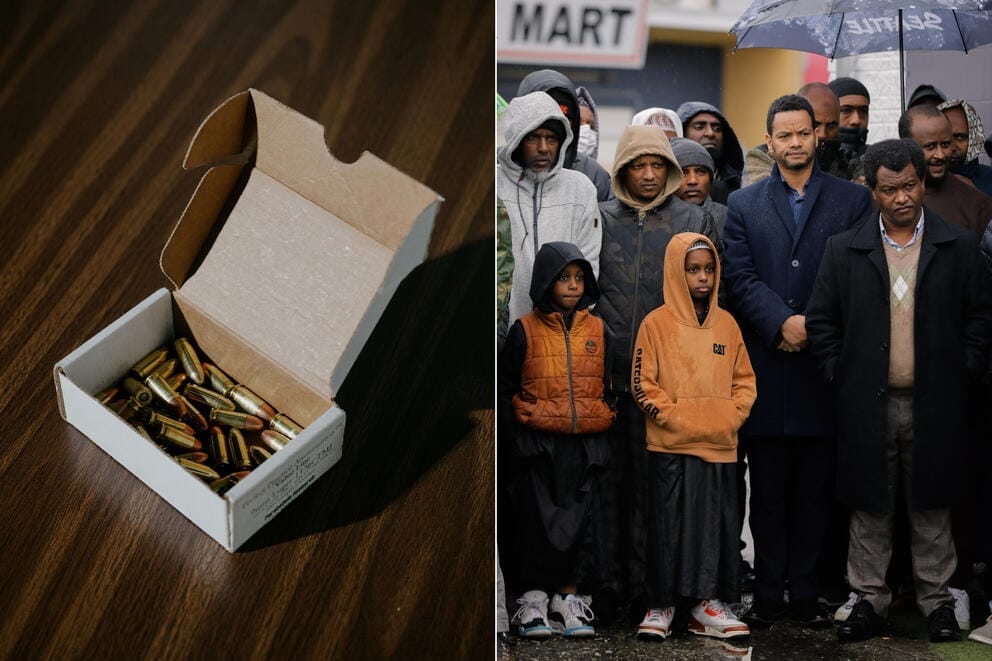
Left: Pistol rounds lie in a box at a range in Bellevue on Nov. 8, 2024. (Grant Hindsley for Cascade PBS)
Right: Community members and family and friends of Mubarak Adam, 15, who was fatally shot outside the Southwest Teen Life Center in West Seattle in January 2024, gather for a rally against gun violence in South Seattle, March 1, 2024. (Genna Martin/Cascade PBS)
The extra time on phones also contributes to a much faster escalation of conflicts as social media beefs spill into the real world.
Helfgott said that for all of us, but especially youths, constant exposure to violent media and video games can play into real-life violence. “Social media, media, digital culture and just seeing images of violence all contribute,” she explained. “Exposure to violence is a risk factor to violence, and virtual exposure to violence can be a risk factor as well.”
Hollingsworth argued that the Seattle-area’s enormous wealth inequality is also a factor. The councilmember said she wishes people understood that low-income kids are often hungry, which can lead to anger and heightened emotions. A study by the National Institutes of Health found that food insecurity is a strong social determinant of gun violence risk.
Economic displacement has also led to less community cohesion. When Hollingsworth was growing up, neighbors would all keep an eye on each other’s children and call parents when kids were getting into trouble. In the 1970s, more than 73% of Central District residents were Black. Today it’s less than 18%.
What are we doing to address it?
The Seattle region appears to be past the pandemic’s violent peak. King County’s Lisch attributes it in part to society’s restabilizing. “School’s back in session, adults who care about youth are accessible again.”
Lisch also credits the work the county and city are doing. “We’re investing in community-led solutions. We are able to reach the young people who, for whatever reason, may be at the highest risk. And as we mature that work, I think we’re going to see the numbers come down.”
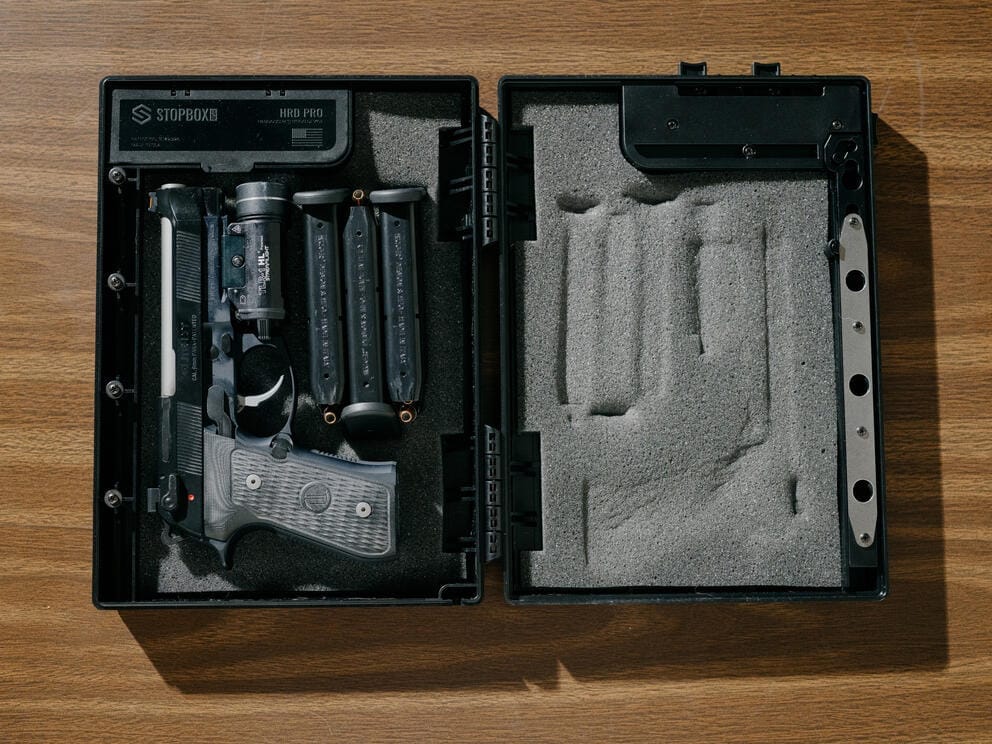
A pistol lies in a Stopbox, a specialty locking box which uses a custom finger actuation, at a gun range in Bellevue on Nov. 8, 2024. (Grant Hindsley for Cascade PBS)
King County’s Regional Office of Gun Violence Prevention, headed by Lisch, was created in October 2023 as part of a new national network of gun violence prevention offices. The Office coordinates the violence prevention programs the county pays for, works with the national network to share best practices and serves as a link to community members.
In 2022, Mayor Bruce Harrell created a new Gun Violence Prevention Liaison role for Seattle. The position exists to advise the mayor’s office on gun violence prevention strategy; act as a go-between for community members and the city; coordinate with Lisch at the county to ensure they’re not duplicating efforts; and engage with the national network.
Harrell hired DeVitta Briscoe for the role in 2022. Briscoe has experienced the firsthand tragedy of gun violence, losing her son Donald to a shooting in 2010 in Tacoma and brother Che Taylor to a police shooting in 2016 in Seattle. Prior to taking the city job, Briscoe was a community advocate focused on violence prevention and police accountability.
Both the county and city have made community violence intervention programs a centerpiece of their gun violence response. Led by grassroots nonprofits including Community Passageways, Urban Family, the Southeast Network SafetyNet and the YMCA’s Alive & Free, violence interrupters intervene immediately after shootings occur to stem retaliatory violence, try to prevent future violence and help victims and their families rebuild after a shooting.
Staff at the violence interruption groups have close connections to the communities they work in and often have personal experience with incarceration or gang membership. Mentors work to build close relationships with young people at risk of becoming gun violence victims or committing violence, as well as having relationships with people who’ve been victimized.
“How do we really build a foundation under that young person so they have a true opportunity of growing and becoming their best self, whatever that looks like? Then if they were a victim of gun violence, how to help them rebuild their life and get to a place where, man, they can live peacefully, they can have an opportunity to really grow,” said Mark Rivers, Community Passageways’ deputy director of community safety. Rivers spoke to Cascade PBS this fall for a podcast series on how hospitals deal with gun violence, including a hospital-based intervention program that’s part of the community violence intervention strategy.
Community violence intervention programs have become a gold standard in many American cities and have contributed to significant drops in shooting incidents in Boston, Oakland, New York and many others.
Since 2020, Seattle has spent $18.6 million on contracts with violence intervention nonprofits. According to King County, its support of community violence intervention groups has led to 500 young people being enrolled in services and resulted in responses to over 400 incidents. The King County Executive Dow Constantine’s 2025 budget included another $7.6 million for the efforts.
But the model hasn’t been without controversy. Audits of the nonprofits have found insufficient oversight in some cases. Most recently, the former head of Freedom Project, one of King County’s contracted providers, was accused of orchestrating a kickback scheme to funnel money to a friend through subcontracts. The former director of SE Network SafetyNet, which contracts with both Seattle and King County, was arrested in October and accused of laundering money for a drug ring.
In 2021, a young man was shot and killed during a violence intervention meeting with Community Passageways. The nonprofit was criticized for not assisting police with their investigation, arguing that doing so would undermine the trust with community it needs to do its work. The family of the victim sued the nonprofit earlier this year.
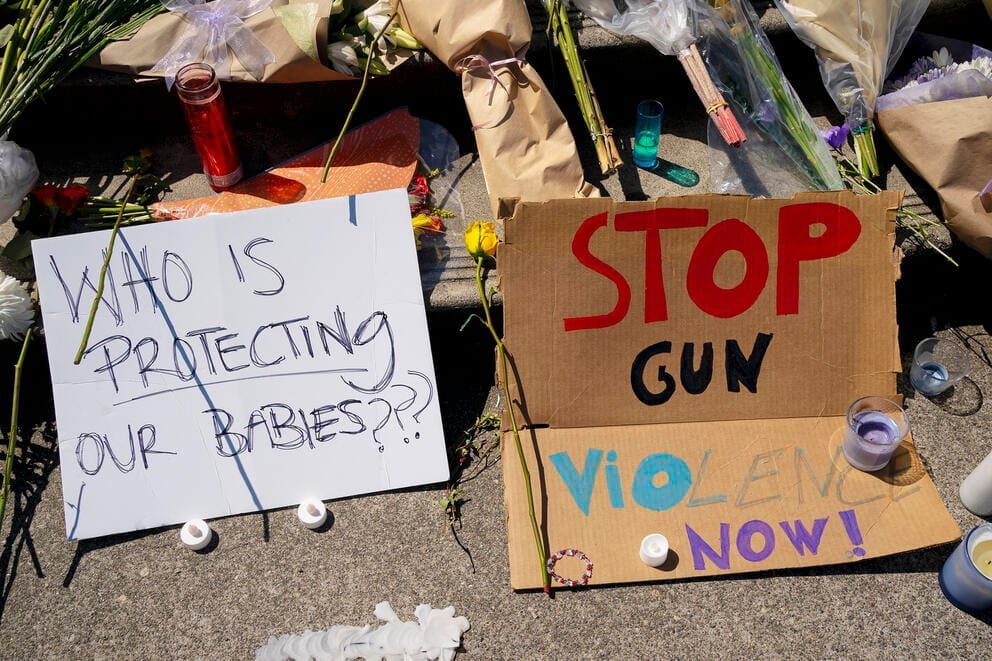
Signs, flowers and other items at a memorial for Amarr Murphy-Paine at Seattle’s Garfield High School on June 8, 2024. While trying to break up a fight, Murphy-Paine was shot and killed in the school’s parking lot. (David Ryder for Cascade PBS)
What’s missing from the puzzle?
Part of Lisch’s and Briscoe’s job is to connect with other cities and keep tabs on other gun violence programs and policies that King County and Seattle could start. But, Briscoe said, “I don’t know if there’s any magic thing out there that’s a shiny new thing we want to try.”
Instead, it’s about scaling up the tools the city and county already have in place.
Part of that scaling, in Briscoe’s view, should include expanding the community violence intervention programs and professionalizing them the way police, fire, EMTs and nurses are professionalized. “They should have the same type of benefits, they should have access to some type of mental health support,” she explained. “All of those things are in place, and they should have a budget, so they don’t have to, you know, lay off their employees or start again.”
During King County’s mid-year budget process, Zahilay included $1 million to bolster the county’s gun violence work. Much of it centered on improving coordination between city and county agencies as well as with first responders, creating a new resource database, and a standard protocol to immediately intervene after a shooting.
“If there’s a shooting at a school, I want it to be automatic that King County’s Public Health Department will reach out to the school and say 'Do you want us to come to your school and provide more mental health resources, more behavioral health resources?’” he explained. “If there’s a shooting at an apartment complex, I want it to be automatic that our Public Health Department will reach out and provide the resources needed by that community to move forward.”
Some experts see a need for police as part of the solution. Not necessarily to prevent gun violence, since police are typically only involved after a shooting has occurred; but Helfgott argued they play an important role, both to investigate gun crimes and to address other public safety concerns with community members. To get there, both Helfgott and Washington agree police need to work to build better relationships with the communities they work in.
“Get out of your vehicles, show up to businesses, introduce yourselves when these youth are getting out of schools,” said Washington. “Just ‘Hi, how you doing?’ It’s all about building community, and how can you be a part of it. They are a part of the ecosystem.”
Seattle Police Department did not respond to Cascade PBS’s multiple requests for interviews for this article.
The Central District Public Safety Accountability group that Appollonia Washington co-founded is also part of that ecosystem. They serve as liaisons between the Central District community and city and police officials. At their monthly meetings, officials report on what they’re doing to improve safety and receive feedback from the community.
Helfgott also thinks in a world so saturated with violent media, better education is critical.
“We need to be educating the public, educating families," she explained. “I think media literacy should be taught in elementary school and all the way up. They are doing that in some countries, but we need to help children understand the difference between fantasy and reality.”
A glimmer of hope
When she looks at the work community violence intervention groups are doing and the additional resources city and county leaders are putting toward gun violence prevention, Washington feels that things are moving in the right direction.
That’s not to say she’s pollyannaish about how hard a problem gun violence is or the tragic impact it has had on her community. Her son went to school with Amarr Murphy-Paine, who was shot and killed at Garfield High School earlier this year. As a result, Washington said, her son’s been saying more frequently that he loves her, explaining that “you never know” when you might get killed. “God, that hurts as a parent,” she said.
At the same time, Washington finds promise in the work that’s being done.
“I know it’s going to take a lot,” Washington said. “But if everybody can come together to make this ecosystem a little bit safer, [it’s going to help.] If I keep being active and vocal about supporting our neighborhood, then I know change is going to continue to come.”


